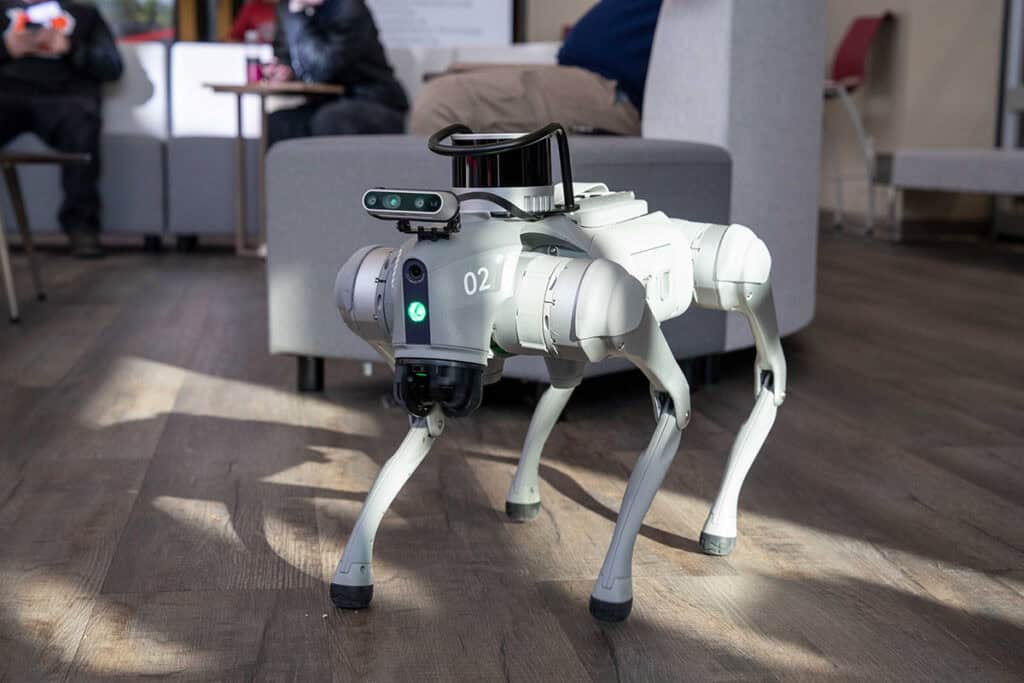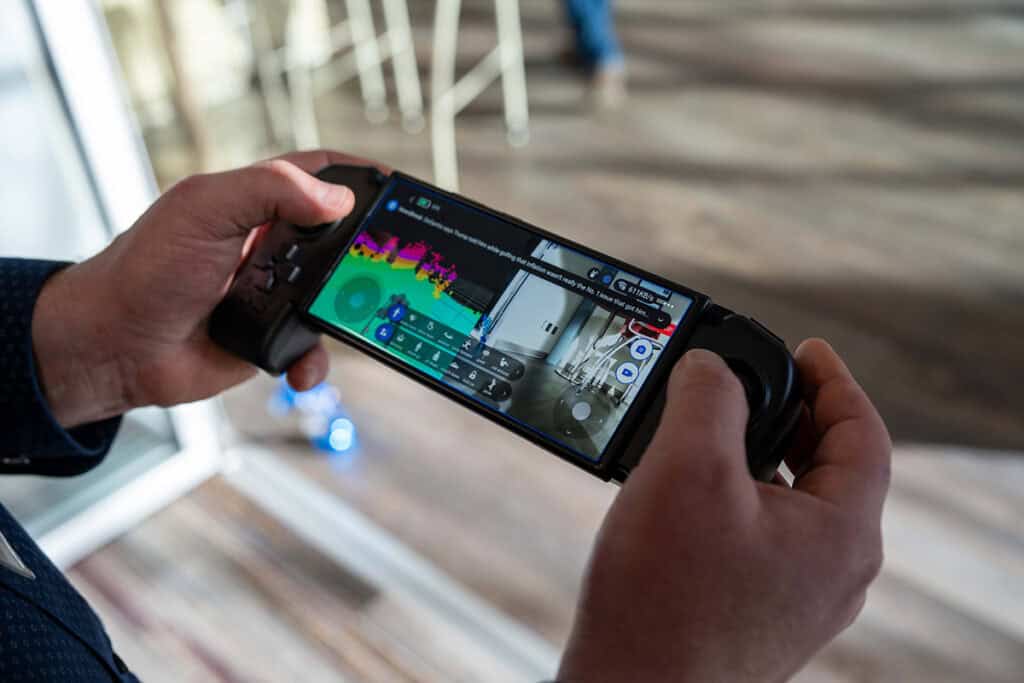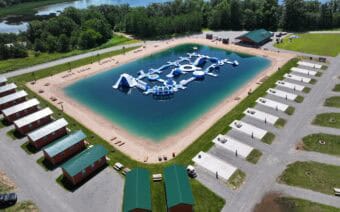
March 3, 2025
STEVENS POINT – Mid-State Technical College’s newest “faculty member,” Red Rover – or, in this case, red “robo” – is settling in at the college’s new state-of-the-art Advanced Manufacturing, Engineering Technology and Apprenticeship (AMETA) Center.
Ryan Kawski, dean for the School of Applied Technology at Mid-State, said the robotic dog (which is awaiting a name) is a new piece of technology featured at the facility, which helps showcase the future of automation and technology.
“Boston Dynamics was the first to create a robot dog, or what’s really called a quadruped,” he said. “When Boston Dynamics came out with Spot the (robot) dog, we said (it) would be really neat to have a Spot.”
After looking into the cost of purchasing a Spot from Boston Dynamics, Kawski said the college determined that quadruped model wouldn’t be the “most financially responsible” one to purchase and started exploring different options.
Then, two years ago, Kawski said they happened upon the perfectly sized robo-pup for Mid-State’s programs and desired use cases.
“I was down in Phoenix, Arizona at the Association of Career and Technical Education Conference – the National ACT conference – and I came across what looked like Spot’s puppy, and it’s a much smaller package,” he said.
“Spot’s puppy,” as Kawski said, was another quadruped called the Go2 model developed by the company Unitree.
“Once we found out that this (model was) a little more financially responsible per se, we set out and procured this quadruped, and it came right around Christmas time,” he said. “Unlike a kid on Christmas, I didn’t tear into the box before we shut down our campus operations between Christmas and New Year’s.”
However, upon his return from the school’s holiday break, Kawski said he “really dug into this thing, got the dog out of the box and started using it.”
Getting ‘hands on the dog’
Kawski said “a number of years ago,” Mid-State’s advisory committee for the college’s civil engineering program started pushing the idea of developing a drones and remote sensing course.
“We purchased and procured a number of different flyable drones with various technologies attached to them, including various LIDAR technologies, cameras and infrared sensors so we could measure and take pictures and create maps, essentially,” he said.
Mid-State’s Go2 quadruped, Kawski said, can do the same things as a flyable drone – only, it has different mobility capabilities.
“It’s essentially a land drone,” he said. “It operates on a remote control very similar to that of an aerial drone. It has an app-based software program that you can operate on your phone. You can actually operate the quadruped off (of your phone), and it has its own remote control via that.”
Kawski said users also have access to the various cameras on the quadruped.
“You can walk around and see where you’re going, and it’s collecting data using its LIDAR sensors,” he said. “So it’s creating a point cloud image (that) you can download and then upload to computer software to build up models.”
Though there are other land-based drones – such as “little RC kind of drones that have wheels and can go across terrain as well” – Kawski said those do not have the same kind of abilities as a quadruped.
“Being that it’s a four-legged robot, it can go up and down steps (and) it can actually jump,” he said. “Our dog can jump about three feet, (it can) pounce, it can dance, it can shake, it can greet you. People are asking, ‘Can it talk?’ And I think it can. I just don’t know how to make it do it just yet. In time, we’ll learn (that) it does a lot of really cool things.”
The Go2 quadruped, Kawski said, also has capabilities that could expand its use beyond Mid-State’s drones and remote sensing course.
“We could actually use it as part of our advanced robotics class as well,” he said. “I watched a couple of webinars where they attach various devices to them.”

One of those devices is an infrared thermal camera, which Kawski said could be useful in industrial settings and applications.
“Think of a large-scale paper mill or manufacturing facility that has a massive production-line machine,” he said. “The dog could actually walk up and down the stairs, it could walk up to a placard on the wall or on the side of the machine – an RFID chip, if you will, (or a) bar code – (and) it would scan that, know its location (and) could report back where it’s located through its cloud-based programming.”
From there, Kawski said the quadruped could be programmed to take a snapshot with an infrared camera.
“(It could check the) bearing where a shaft is turning, and it could measure if it’s the right temperature – (making sure that) the bearing isn’t getting too hot and could be going out of service, or be it a failed bearing location,” he said. “Then the quadruped (can be) programmed to walk that same path every so many hours.”
The quadruped, Kawski said, is ready to be utilized by Mid-State’s students starting this spring.
“It’ll be used in our drones and remote sensing course, which we’ll run in the second eight weeks of our spring term – so we’ll start that course up right after our spring break,” he said. “Students will have their hands on the dog and get to take it for a walk, if you will, and learn about the technology.”
Mid-State’s ‘wow’ factor
As leadership fundraised for and built the new AMETA center, Kawski said Mid-State President Shelly Mondeik “challenged all of us” at the School of Applied Technology to think about what their “wows” were going to be.
“We literally have a media wall in the facility – it’s a 12-foot-by-14-foot tall video display – that we call our ‘Wow Wall,’” he said. “One of the ‘wows’ is definitely this quadruped, this robot dog.”
Kawski said some people are amazed by the technology.
Others, he said, are “kind of creeped out by it.”
“It moves, functions and walks around so similar to that of a real dog that it’s (sometimes) kind of unsettling,” he said. “It definitely attracts people.”
Kawski said he’s had people ask to pet the robot dog, and recently – while hosting a Boys and Girls Club event – a young man asked what the quadruped’s name was.
“We don’t have a name for it, so our Dean of Outreach and Enrollment, Jackie Esselman, reached out to me and said, ‘Ryan, we’ve got to create a marketing campaign,’” he said. “So (during) the month of February – being that it was Career and Technical Education Month here in Wisconsin – we decided to do a name the dog campaign. We received, I think, well more than 30 name suggestions.”
The college, Kawski said, is poised to select the Go2 quadruped’s name from the submission list sometime very soon.
“Early in March, we’ll pare the list down and determine the name for our dog,” he said.
For those interested in interacting with the robot dog or seeing any of the other pieces of technology featured at Mid-State’s new AMETA Center, Kawski said folks are encouraged to reach out through the college’s website.
“There’s an opportunity for folks to schedule tours, to connect with us,” he said. “The idea (of AMETA was to create) a showcase facility with the latest and greatest in technology, and we really want all the various businesses across the state, the regions and locally to know that. We want to make sure that we are their educational provider of first choice in the community.”
Visit mstc.edu/ameta to learn more.
 Firm roots in the past, with an eye on the future
Firm roots in the past, with an eye on the future 3Elephants & Company never forgets ‘hometown feel’
3Elephants & Company never forgets ‘hometown feel’








